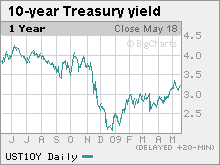Treasury prices sit tight
Debt prices are little changed after a government report shows weakness in the housing market. Libor hits another record low.
NEW YORK (CNNMoney.com) -- Treasury prices flip-flopped throughout the session Tuesday as investors digested a weaker-than-expected housing report and awaited the release of the minutes from the Fed's last meeting.
Separately, a key lending rate continued its run of record lows.
Stocks have been rallying for the last two months as investors bet the economy is on the track to recovery. Monday's big rally on Wall Street was expected to be followed by gains Tuesday. Treasury prices fell Monday and continued to retreat early Tuesday.
But that trend changed after the Commerce Department reported its April figures for housing starts and building permits, which both set record lows.
Housing starts in April dropped nearly 13% to the seasonally adjusted annual rate of 458,000. Building permits fell 3% to an annually adjusted rate of 494,000 in April.
While debt prices changed direction after the dour housing report, neither the bond market or the stock market reacted dramatically to the data.
"The Treasury market is trading pretty much unchanged across the yield curve, even though the housing numbers were atrocious," said Kevin Giddis, managing director of fixed income at Morgan Keegan, in a research note. He said the reaction was muted because investors are mostly on the sidelines, waiting for a more clear indication that the economy is moving one way or the other.
"All the shoes have dropped and given enough time, the problem areas (banks, housing and employment) will work themselves out," said Giddis. "Unfortunately, the results and the timing may underwhelm those who were hoping for a V-shaped recovery."
Waiting for Fed minutes: Investors were waiting for the Wednesday release of the minutes from the last Federal Open Market Committee meeting in April. Analysts will dissect the language of the meeting for signs the government might expand its debt buyback campaign.
The so-called quantitative easing program involves the Federal Reserve purchasing its own debt in an effort to keep pressure on yields. Key lending rates, including home mortgage rates, move in tandem with yields on Treasurys. The government is trying to keep lending rates low to spur economic activity.
On Monday, the Federal Reserve also bought $3.2 billion worth of debt that matures between August 2019 and February 2026. The central bank is due to buy an undisclosed amount of debt Wednesday and Thursday.
Bond prices: The benchmark 10-year note edged down 3/32 to 98 31/32, and its yield rose to 3.25%. Bond prices and yields move in opposite directions.
The 30-year bond fell 4/32 to 100 23/32, and its yield increased to 4.21%.
The 2-year note increased 1/32 to 99 31/32, and its yield fell to 0.90%. The yield on the 3-month note steadied at 0.19%.
Lending rates: A key bank-to-bank lending rate fell to another all-time low Tuesday, an indication that banks were increasing their lending.
The 3-month Libor fell to 0.75% Tuesday, down from 0.78% Monday and that was down from 0.83% Friday, according to Bloomberg.com. The two day drop in the 3-month Libor was the biggest in nearly 4 months.
Two weeks ago, the 3-month rate dropped below 1% for the first time since 1986, when the British Bankers Association started keeping records. The overnight Libor rate was unchanged from 0.22% Monday.
Libor, the London Interbank Offered Rate, is a daily average of rates that 16 different banks charge each other to lend money in London. The closely watched benchmark is used to calculate adjustable-rate mortgages. More than $350 trillion in assets are tied to Libor. ![]()


